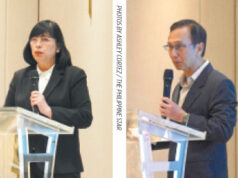Christmas celebration in the Philippines is known as the longest and merriest in the world. As September kicks in, Christmas carols and decors are already heard and assembled in malls and households until the Feast of Epiphany or Three Kings on Jan. 6.
The Christian roots and beliefs of Filipinos, together with the influences of western countries, have fascinatingly mixed with the local traditions, and have resulted to unique and exceptional festive. From get-together to meaningful masses at the church, the spirit of Christmas, which is a celebration of love and thanksgiving, is sincerely observed throughout the archipelago.
Aside from gigantic Christmas trees and gleaming lights in the streets and malls, unique Filipino decorations such as “parol” and “belen” add excitement to the much-awaited season.
“Parol” is a five-point, star-shaped Christmas lantern made from bamboo strips, colored with a Japanese paper or cellophane paper, and illuminated with candle or “kalburo”. This iconic Filipino Christmas lantern is as important as the Christmas tree of the Western countries because hanging “parol” outside the house represents the star of Bethlehem that guided the three wise men to the manger of the newly born Jesus Christ.
Initially, “parol” is made to light up the way of Filipinos who go to church for the “Simbang Gabi”. Instead of putting the lanterns away, people bring and hang them outside their houses. As years went by, the Filipino lantern evolved into something brighter and creative. “Parol” made from various shapes were invented, and “parol” made from capiz shells and colorful lights became popular. Schools and communities across the country hold “parol-making” contests to make the season more exciting and to see who can make the best-looking “parol”. In the city of San Fernando, Pampanga, a Giant Lantern Festival is held every year, where giant and stunning stars are presented and lit up on the streets.
Another traditional Filipino Christmas symbol is the “belen”. It is a tableau representing the nativity scene or the birth of Jesus Christ. “Belen” was introduced in the Philippines by the Spanish Franciscans during the colonial period. Normally, it is a manger surrounded by the Virgin Mary, St. Joseph, the shepherds, their flock, the Three Kings and some animals and angels. It can be seen in churches, homes, schools and office buildings, in which different materials are used to come up with meaningful and beautiful display.
Before the actual Christmas day, various traditions and practices are observed in the country. Christmas parties are organized in offices, schools and communities in the second to third weeks of December. Different contests and parlor games are held, but the much awaited part is the exchanging of gifts.
In the Philippines, a unique form of exchange gift is called “Monito-Monita”. Days before the party, participants’ names, together with their wish or preferred gift, are written in a paper and draw to every participant. To make it more exciting, the name of a person’s “Monito” or “Monita” shall be kept secret until the revelation day. As part of the tradition, some groups agree to give their “Monito” or “Monita” a small gift every day or every week, depending on the category or theme.
“Simbang Gabi” or “Misa de Gallo” is also practiced by Filipinos. It is a nine-day series of masses from Dec. 16 to 24 to honor the Blessed Virgin Mary. Many Filipinos aim to complete the “Simbang Gabi” in the hope of having their wish granted. The tradition was introduced by the Spanish friars to primarily allow farmers to attend the mass before working in the fields.
After attending the “Simbang Gabi”, it has been part of the Filipino tradition to buy and eat native delicacies such as “puto bumbong” and “bibingka”, sold outside the churches.
“Puto bumbong” is traditionally made from a special variety of heirloom sticky or glutinous rice called “Pirurutong”, which has a distinctly purple color. After it is soaked in salted water and dried overnight, it is poured into bamboo tubes and steamed until done. To make it more appetizing, it is served with sugar, cheese and condensed milk.
On the other hand, “bibingka” is a round rice cake made with rice flour and coconut milk, baked in a clay oven with the coals underneath and on top. It is topped with cheese and egg or salted egg, and brushed with butter.
Dec. 16 also marks the start of caroling, where a group of people, usually kids, together with their instruments such as drums, guitar and tambourine, sing Christmas songs to every houses they visit. In return, the homeowners rewarded the carolers with money or present. Today, caroling has become a fund-raising activity by some groups to generate fund for their Christmas party or for a special cause. Although caroling officially starts on Dec. 16 to 24, Christmas songs, especially Jose Mari Chan classics, are played in shopping malls and on the radio as early as September.
On Christmas Eve, another unique Filipinos tradition called “panunuluyan” is observed. It is a dramatization of the search for Bethlehem by Joseph and Mary right before the birth of Jesus Christ, which is staged in many towns, cities, and provinces of the country. The “panunuluyan” procession commences with the images of St. Joseph and the Virgin Mary being wheeled out on floats out of the church at around 7 p.m. The ritual is completed in reenactments, seasonal hymns, prayers, fellowship and a reflection on the Christian’s journey towards salvation.
Many people stay up late to welcome the most important day of the season, the Christmas day. After hearing the last mass or the Christmas Eve mass from the church, family members, friends and neighbors dine together for a feast called Noche Buena. During the grand dinner, native and foreign cuisines such as roasted pig, pancit, ham, rice cakes and queso de bola are served. Noche Buena has been the tradition of many Filipinos to wish everyone a merry Christmas.
Amidst the grand celebration, the true essence of Christmas remains at the heart of Filipinos. A lot of ways are practiced by Filipinos to express their love and gratitude. On the actual day, children often wear their finest clothes when visiting their relatives and godparents, and observe the Filipino tradition of “pagmamano” as an act of respect to elders. Most of the time, the children are rewarded with “aguinaldo” or gifts like toys or money. The act of gift giving is extended until the first day of the new year. — Mark Louis F. Ferrolino



